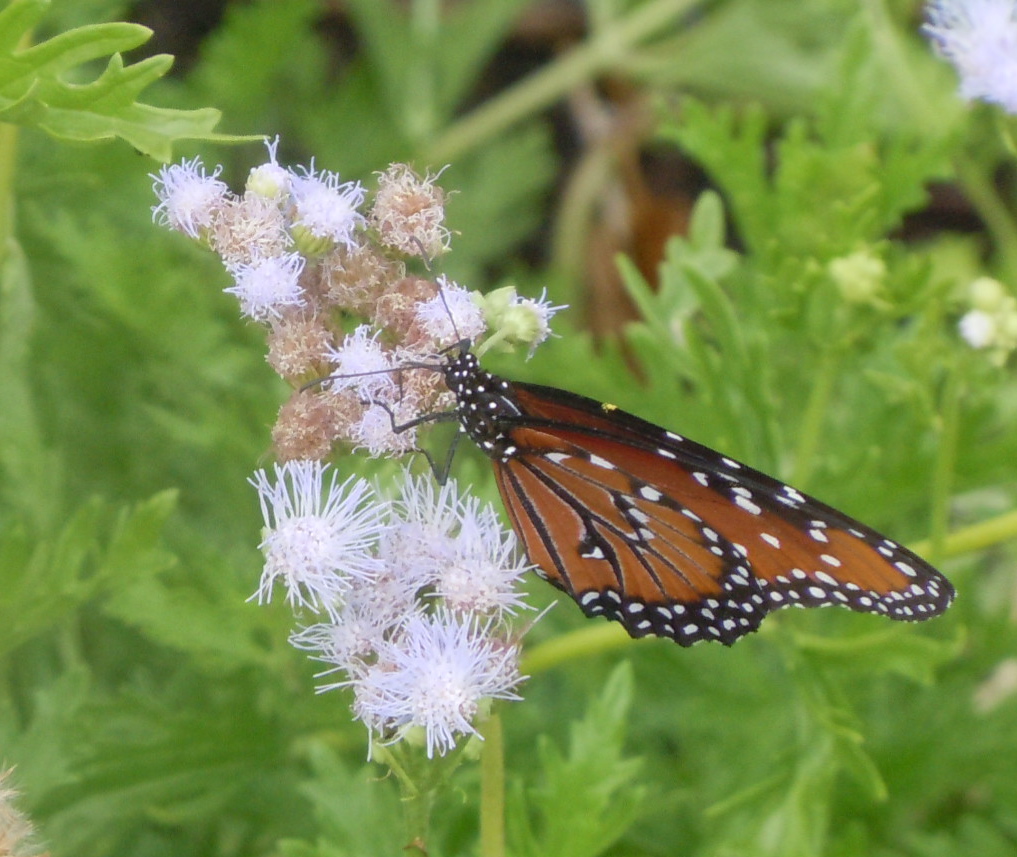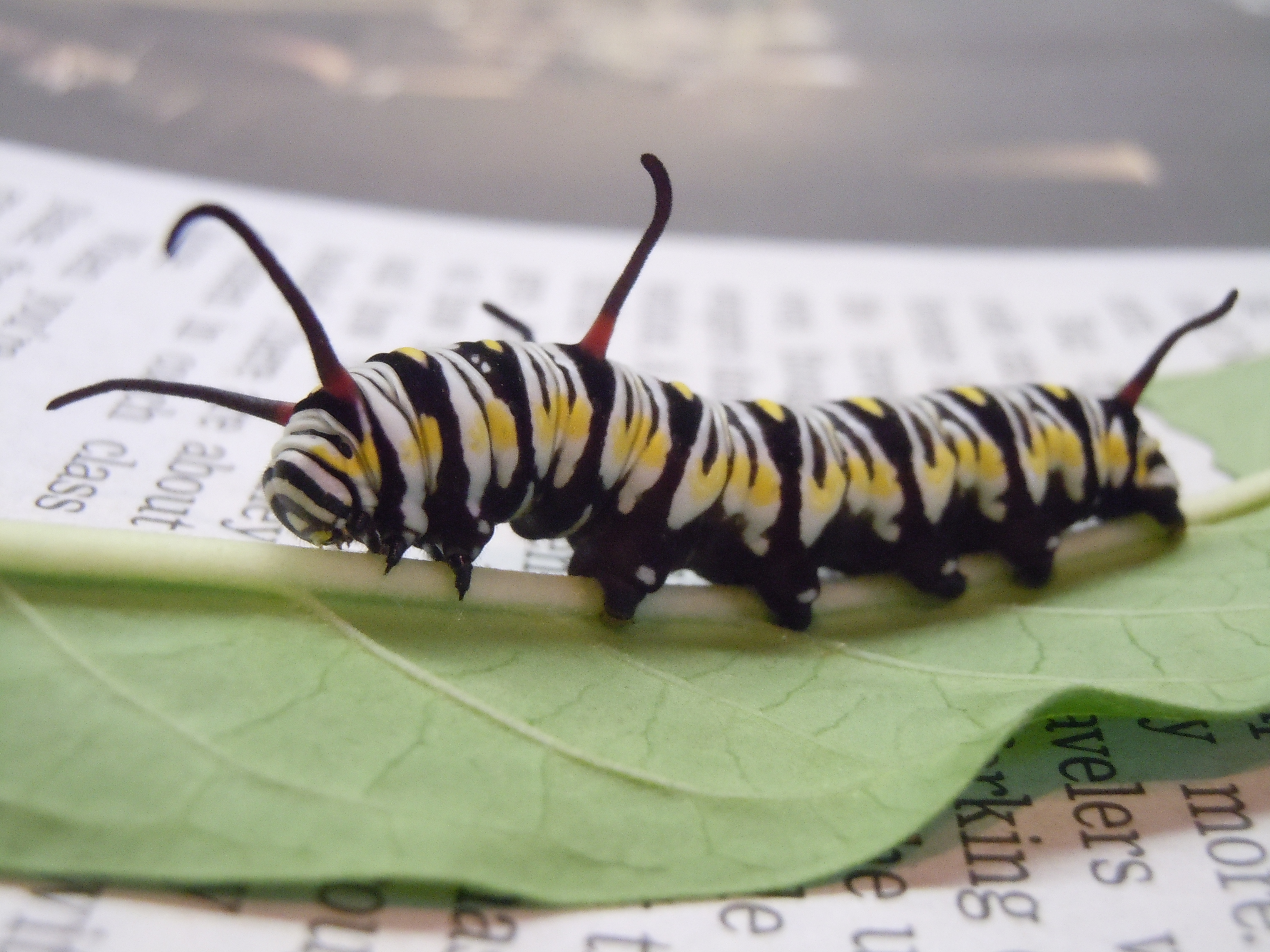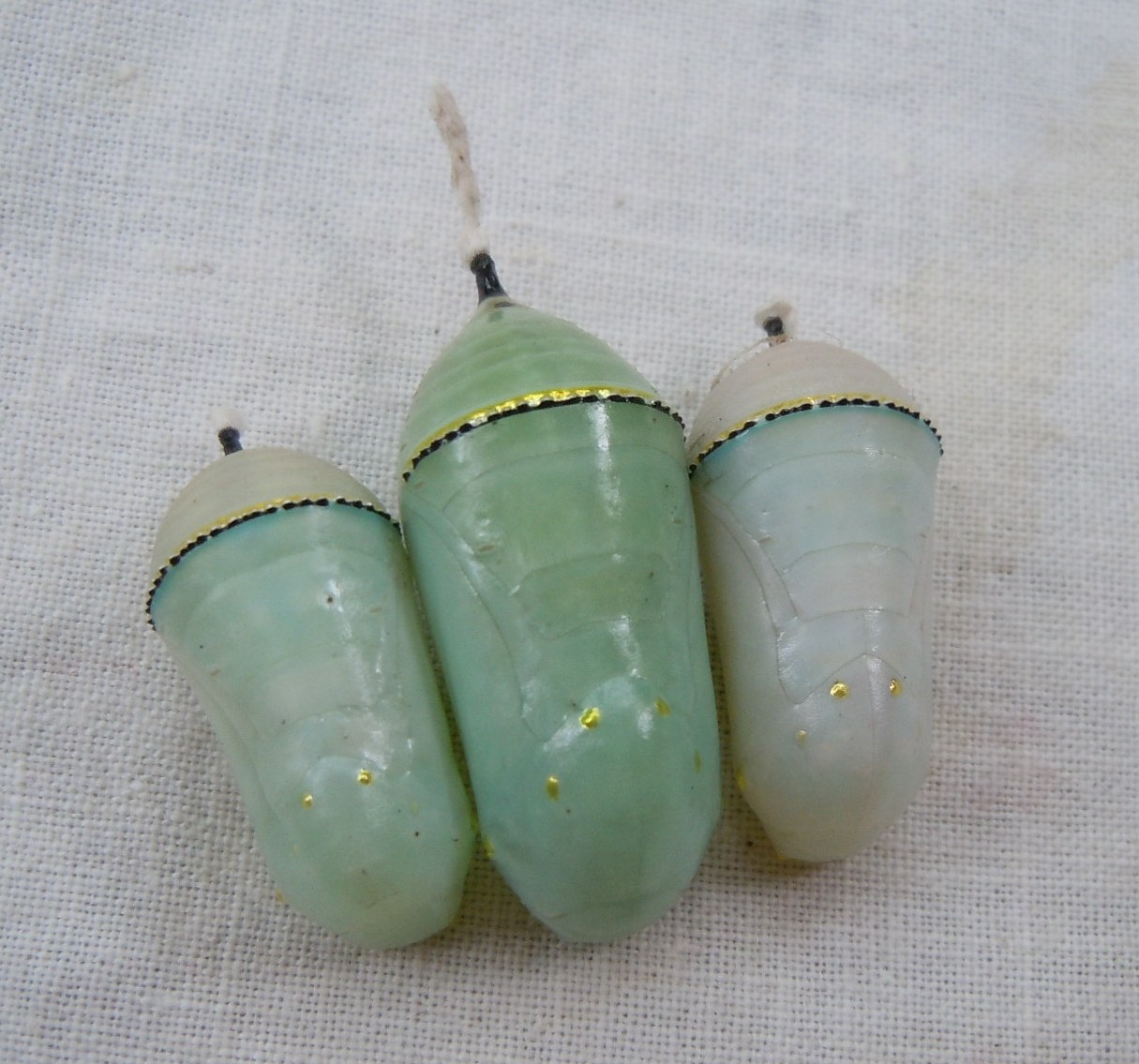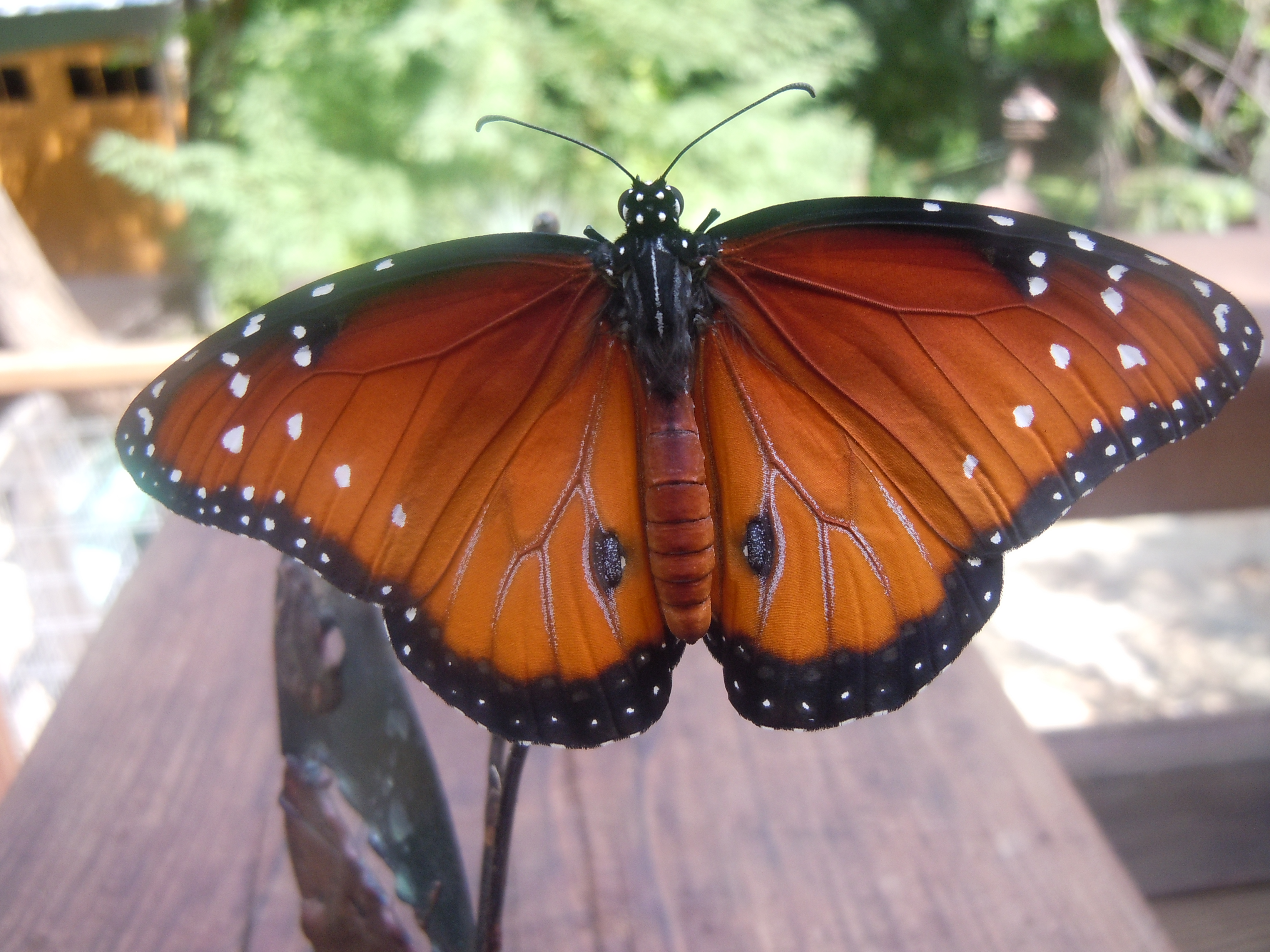We start seeing Queens in August, and this year is no different. Queens, Danaus gillippus, share the multiple charms of Monarchs, Danaus plexippus. Both flaunt large size, flashy, striped caterpillars and chrysalises that resemble a jade crystal flecked with gold.

Queens are back in town. Here, on Butterflyweed, Asclepias tuberosa.
If you’re lucky enough to have flowers blooming these brutal summer days, you’re likely seeing the burnt orange creatures. Like Monarchs, Queens lay their eggs only on milkweed, but they nectar indiscriminately. We had a few pass through our urban front yard garden this week, nectaring on lantana, Tropical milkweed and their favorite, Gregg’s purple mist flower.

Male Queens LOVE purple mistflower.
If you want Queens in your garden, we recommend planting mistflower. The bloom of the mistflower contains a special alkaloid that male Queens ingest, sequester, and later release as an aphrodisiac to attract females.
Distinguishing Monarchs from Queens can challenge butterfly observers. They appear identical on first glance, but look closely and you’ll see that Queens are a solid dark orange, with wings folded. Monarchs have much more variation in their coloring. With wings open, the difference is more striking. Queens
display none of the “stained glass” veins of Monarchs (see the banner photo at the top of this web page). Queens’ open wings boast a solid orange-brown, with only white specks on the outer edges and a black outline.
In the caterpillar stage, Queens flaunt similar Monarch-like yellow and black stripes, but they also sport three sets of filaments, the amusing antennae-like protuberances that seem to feel the world around them in expressive contortions. Monarchs display only two. Queens also wear a red accent where those filaments connect to the caterpillar, presumably a warning sign to predators.

Queen caterpillar with three filaments. Monarchs only have two.
As a chrysalis, Monarchs and Queens could be twins, except that Queens are slightly smaller. Both attach themselves vertically from a a horizontal surface with a silk button after forming a “J” shape, then spin a shiny green chrysalis flecked with gold dots. While

Queen and Monarch chrysalises. Monarch in the middle.
some butterfly species opt for disguises verging on the disgusting in the chrysalis stage–as bird droppings (Red-spotted Purples) and dried crinkled leaves (Gulf Fritillaries)–Queens and Monarchs win the chrysalis beauty pageant. Their fantastic jade coloring and intriguing gold flecks provoke some folks to wear them as jewelry. (Not something I recommend.)
For more tips on how to tell the difference between Queens and Monarchs, see these blogposts from the Texas Butterfly Ranch archives:
Like what you’re reading? Follow butterfly and native plant news at the Texas Butterfly Ranch. Sign up for email delivery in the righthand navigation bar of this page, like us on Facebook, or follow us on Twitter, @monikam. You can also read our stuff on the Rivard Report.Queen Butterfly or Monarch Butterfly? Sometimes it’s Hard to Tell the Difference
How to tell the Difference between Future Monarch Butterflies and Future Queen Butterflies, Part II


Great article! By the way, Queen chrysalises can be pink instead of green. We had one that was that color. Click here https://picasaweb.google.com/Lmreid71Butterflies/Queen#5366963104332872258 to see a photo of it. The butterfly emerged as a gorgeous male 🙂 https://picasaweb.google.com/Lmreid71Butterflies/Queen#5366961786390669650
Lisa, I know! Love the variety of pink chrysalises. The ones in the photo above were pink, but the photo doesn’t do them justice. Thanks for writing. –MM
Great post! We have some male Queen butterflies in our garden. They are all over our Mist flower. Is it to late in the season for Queens or Monarchs to lay eggs? I haven’t seen any cats on my milkweed. I’m hoping the migrating Monarchs will lay their eggs on the milkweed in the fall.
Queens and Monarchs will lay eggs this fall. When temperatures are lethally high, it can effect mortality. You should see some eggs and caterpillars later, as it cools off (hopefully) a bit. Good luck and thanks for writing. –MM
Hi Monika
That’s very interesting. We don’t have Queens here (in New Zealand) and I have never heard anyone talking about their migration. Where are they going to, does anyone know? Where do they overwinter?
We do have Monarch butterflies here in NZ, of course. They flew/blew here from North America way back, over 150 years ago! Now that we have their host plants (milkweed species mostly from Africa!) they are naturalised.
Look forward to learning more.
Jacqui Knight
Secretary – Monarch Butterfly NZ Trust (www.monarch.org.nz)
Hi Jacqui,
I’m not sure the “migration” of Queens has been well documented. I know they move through Texas seasonally, usually before and around the same time as Monarchs. I don’t believe they overwinter enmasse like Monarchs. Thanks for writing.
MM
Your blog is so helpful I’m so glad to have discovered it while researching butterflies in my own yard.
I linked to you in my post today: http://rockoakdeer.blogspot.com/2012/08/hot-wheels-and-butterflies_10.html
If you want to grow your own milkweed hostplant, check out this site for free seeds. We planted some over a year ago, and our plant looks great, and we had quite a number of monarchs last summer.
http://www.livemonarch.com/free-milkweed-seeds.htm
Nice article. You always bring out some detail that I have missed. Also, the pink crysalis is very interesting. I would have assumed something was wrong if I got one like that! I don’t think Queens migrate much – nothing like the Monarch. I thought for sure that while talking about the royalty you would mention soldiers! We do get some of those in South Texas. Maybe next time.
My mom and I used to search milkweed fields for caterpillars for her to grow in her classroom. The spring she died, milkweed popped up right by my front door. I was so excited today to find two caterpillars eating and used your site to check that they were really monarchs and not copy cats. Thanks for the clear explanations and pictures. It’s been a long time since I’ve watched them.
By the way, I am in PA
I saw my first ever black Witch moth on my covered deck…thinking it was a bat so I got my camera and saw it was truly a large moth. Even then I wasn’t wanting it to come too close! This one had a 6-7” wingspan. Thank you for the article.
It is Sept.10, 2019, in San Miguel de Allende, Mexico. I have had one of these huge moths show up for the past 4 days. We chase them out so not sure if it is the same one or different ones. Thought it was a bat, the dogs go crazy, got it on a long long duster last night to get it out of my bedroom and into the yard. A few minutes ago one flew in the back door and then out the door to the upstairs Sala. Amazing. Must say I prefer the Momarchs, which we also have. Becki Carney
Hi! great article. My only suggestion is to remove the reference to how monarchs ‘spin’ their chrysalis. I think that can be confusing. Folks often don’t understand the difference between a chrysalis and a cocoon. Moth caterpillars spin their cocoon. thanks!